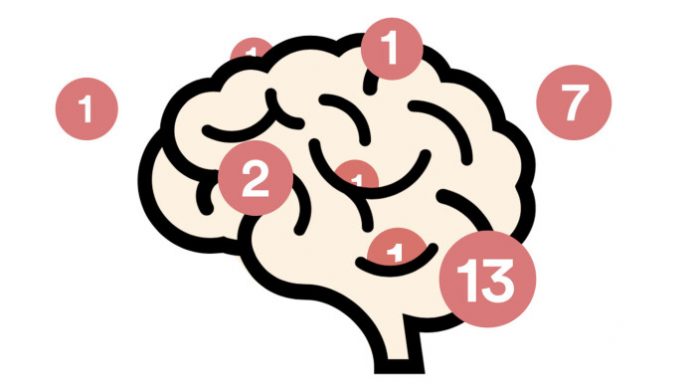I still remember the anticipation of opening the pack. I’d often look at the five cards side-on first to see if there was a foil badge. That thrill at having, in order of desire 1) the Glasgow Celtic badge, 2) any Glasgow Celtic player 3) any foil club badge would, more than 90% of the time end in disappointment. And so the dilemma would begin on whether to sacrifice another hard-earned 20p for another pack. I would surely get what I wanted next time.
Pannini Scottish football stickers in the 1980s. Who was I to know that this experience would foreshadow the daily digital existence for me, and a large chunk of humanity, over 30 years later.
Micro-doses of dopamine are central to both these seemingly worlds-apart experiences. Dopamine is the reward hormone and plays a role in many forms of addiction, from drugs and food to social media and smartphone use in general. It is more than the pleasure chemical, a common misconception, as it represents the first part in the process, where reward is noticeable or better than expected. The brain is told to pay attention to the stimulant in question as it may be important for survival in the future, prioritizing it over older, more predictable rewards.
Many researchers believe it is more about drug wanting than liking. The anticipation and unpredictability of the drug in question – say social media use through red bubble notifications – is therefore the main reason for persistent use in spite of negative consequences. The negative consequences of drug or food addiction are of course well known, with greater understanding now beginning to emerge on digital device addiction – compromised wellbeing being the main result. Many social media designers play on the brain function associated with dopamine, with features such as notifications appearing after a short delay (likened by some as playing a slot machine) in order to maximize the brain’s anticipation and levels of dopamine.
This is part of the reason that the Vodafone Institute’s chief scientific advisor Dr. Nuria Oliver believes Big Tech is often “not on our side” designing products that exploit our weaknesses and leave us disempowered. The random reward and positive re-enforcement (a comment, like or share) from social media use in particular leads to us checking our phones over 150 times per day, decreasing the richness of human to human interaction.
This is not to say there is no benefit to digital technology use. Yet there ought to be a more nuanced relationship with technology that is more than the binary ‘on’ or ‘off’. Impending changes in the labour market and the increasing need to re-invent ourselves during a longer career requires mental toughness, yet mental health seems to be getting worse rather than better, especially for young people.
Many of the points raised by Dr. Oliver are echoed by the Center for Humane Technology, a US-based think tank comprised of former Big Tech employees who believe we are in a “race to the bottom of the brain stem to extract human attention.” Their work focuses on actions to reverse human downgrading and help drive a new generation of humane technology that embraces human nature.
Research will play a big part in a more positive digital future. Some of Oliver’s research on smartphone addiction has looked at boredom. Perhaps not the first aspect that comes to mind in terms of our positive human nature, yet “killing boredom” through smartphone use has its consequences. Some researchers have found it to be a necessary transient state for creativity to flourish, while countless serendipitous conversations at the bus stop or other queues have not taken place due to our new waiting habits in the smartphone era.
As American poet Dorothy Parker once remarked, “the cure to boredom is curiosity.” It is an emotional state that signals that your current activity or goals do not satisfy your needs or sufficiently motivate you. It is through the process of being bored that we look for other more interesting, fulfilling, or challenging activities. Yet today we flee from being bored and are increasingly subjecting ourselves to continual stimuli. This may defeat the actual purpose of boredom and lead to behavioural states representative of compromised wellbeing, including addiction, anxiety, and attention deficit disorder.
Through the use of experience sampling, Oliver looked at users’ emotional states throughout the day – including happiness, excitement, and boredom – together with information about their context and mobile phone usage. In their work, they build machine learning models to automatically infer boredom from the patterns of usage of the smartphone and the operating context at that time – including information on location, movement, temperature, humidity, and screen time. The ultimate goal is to help users by providing content and appropriate suggestions. This doesn’t mean, however, that the aim is to “kill” boredom or provide constant stimuli. By better understanding boredom, Oliver may better help people when they need to disconnect and so rather than endlessly cycle through social media and other frequently visited sites, provide nudges to other interesting and relevant content, or even suggest to turn the phone off, relax, and engage with the real world instead. The overarching aim is to develop technology that adapts to people and has peoples’ wellbeing at its core, not the other way around.
Such nudging strategies are increasingly coming into the digital realm after being firmly established in our physical environment the past few years through the work of Nobel Prize winner Richard Thaler and others. Former Head of People at Google, Lazlo Bock founded Humu a firm which specialises in digital nudging to ultimately improve workplace wellbeing and performance.
There may also be a part for regulation. Oliver notes that the now powerful Food and Drug Administration didn’t exist 100 years ago, and that similar checks and balances may yet emerge from a central body to help guide the technology that is “food for our brains.”
And we all have a role to play. Maybe I shouldn’t expect too much from my 8 year-old self regarding my Pannini purchasing habits – much more worryingly an 8 year-old today and their social media habits – yet as the adult digital consumers of today, we need to appreciate our own responsibility, developing a more mindful approach to our technology use. Willpower is a muscle that can be strengthened. Digital wellbeing – more than just minimizing use, but thinking on how and why we use technology – presents us with the perfect gymnasium to work out.
About the Author
 Dr. Steven MacGregor is the CEO of The Leadership Academy of Barcelona [LAB] an executive education provider and management consultancy with clients including McKinsey, Telefónica and Uber. A Visiting Fellow at the Glasgow School of Art he teaches on open and custom programs at IMD, IE, IESE and CEIBS. Formerly a visiting researcher at Stanford and Carnegie-Mellon he is the author of Chief Wellbeing Officer (LID 2018)and Sustaining Executive Performance (Pearson 2015). His twitter handle is @spmacg.
Dr. Steven MacGregor is the CEO of The Leadership Academy of Barcelona [LAB] an executive education provider and management consultancy with clients including McKinsey, Telefónica and Uber. A Visiting Fellow at the Glasgow School of Art he teaches on open and custom programs at IMD, IE, IESE and CEIBS. Formerly a visiting researcher at Stanford and Carnegie-Mellon he is the author of Chief Wellbeing Officer (LID 2018)and Sustaining Executive Performance (Pearson 2015). His twitter handle is @spmacg.




































